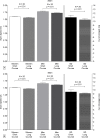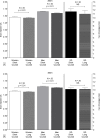The effect of course length on individual medley swimming performance in national and international athletes
- PMID: 25414752
- PMCID: PMC4234758
- DOI: 10.2478/hukin-2014-0073
The effect of course length on individual medley swimming performance in national and international athletes
Abstract
Effects of course length (25 m versus 50 m) and advances in performance of individual medley swimming were examined for men and women in Swiss national competitions and FINA World Championships during 2000-2011. Linear regression and analysis of variance (ANOVA) were used to analyse 200 m and 400 m race results for 26,081 swims on the Swiss high score list and 382 FINA finalists. Swiss and FINA swimmers of both sexes were, on average, 4.3±3.2% faster on short courses for both race distances. Sex-related differences in swim speed were significantly greater for FINA swimmers competing in short-course events than in long-course events (10.3±0.2% versus 9.7±0.3%, p<0.01), but did not differ for Swiss swimmers (p>0.05). Sex-related differences in swimming speed decreased with increasing race distance for both short- and long-course events for Swiss athletes, and for FINA athletes in long-course events. Performance improved significantly (p<0.05) during 2000-2011 for FINA men competing in either course length and FINA females competing in short-course events, but not for Swiss swimmers. Overall, the results showed that men and women individual medley swimmers, competing at both national and international levels, have faster average swimming speeds on short courses than on long courses, for both 200 m and 400 m distances. FINA athletes demonstrate an improving performance in the vast majority of individual medley events, while performance at national level seems to have reached a plateau during 2000-2011.
Keywords: pool length; sex-related difference; swim speed; temporal trends.
Figures




Similar articles
-
Changes in sex difference in swimming speed in finalists at FINA World Championships and the Olympic Games from 1992 to 2013.BMC Sports Sci Med Rehabil. 2014 Jun 25;6:25. doi: 10.1186/2052-1847-6-25. eCollection 2014. BMC Sports Sci Med Rehabil. 2014. PMID: 25120914 Free PMC article.
-
Changes in breaststroke swimming performances in national and international athletes competing between 1994 and 2011 -a comparison with freestyle swimming performances.BMC Sports Sci Med Rehabil. 2014 May 9;6:18. doi: 10.1186/2052-1847-6-18. eCollection 2014. BMC Sports Sci Med Rehabil. 2014. PMID: 24826211 Free PMC article.
-
Sex-related differences and age of peak performance in breaststroke versus freestyle swimming.BMC Sports Sci Med Rehabil. 2013 Dec 19;5(1):29. doi: 10.1186/2052-1847-5-29. BMC Sports Sci Med Rehabil. 2013. PMID: 24351335 Free PMC article.
-
Sex Differences in Swimming Disciplines-Can Women Outperform Men in Swimming?Int J Environ Res Public Health. 2020 May 22;17(10):3651. doi: 10.3390/ijerph17103651. Int J Environ Res Public Health. 2020. PMID: 32456109 Free PMC article. Review.
-
Race Analysis in Competitive Swimming: A Narrative Review.Int J Environ Res Public Health. 2020 Dec 24;18(1):69. doi: 10.3390/ijerph18010069. Int J Environ Res Public Health. 2020. PMID: 33374118 Free PMC article. Review.
Cited by
-
Comparing cross-sectional and longitudinal tracking to establish percentile data and assess performance progression in swimmers.Sci Rep. 2022 Jun 18;12(1):10292. doi: 10.1038/s41598-022-13837-3. Sci Rep. 2022. PMID: 35717501 Free PMC article.
-
Contributions of each of the four swimming strokes to elite 200-400 individual medley swimming performance in short and long course competitions.PeerJ. 2023 Dec 15;11:e16612. doi: 10.7717/peerj.16612. eCollection 2023. PeerJ. 2023. PMID: 38111656 Free PMC article.
-
Ice swimming - 'Ice Mile' and '1 km Ice event'.BMC Sports Sci Med Rehabil. 2015 Sep 3;7:20. doi: 10.1186/s13102-015-0014-9. eCollection 2015. BMC Sports Sci Med Rehabil. 2015. PMID: 26339489 Free PMC article.
-
Start Fast, Swim Faster, Turn Fastest: Section Analyses and Normative Data for Individual Medley.J Sports Sci Med. 2022 Jun 1;21(2):233-244. doi: 10.52082/jssm.2022.233. eCollection 2022 Jun. J Sports Sci Med. 2022. PMID: 35719225 Free PMC article.
-
Differences in Race Characteristics between World-Class Individual-Medley and Stroke-Specialist Swimmers.Int J Environ Res Public Health. 2022 Oct 20;19(20):13578. doi: 10.3390/ijerph192013578. Int J Environ Res Public Health. 2022. PMID: 36294159 Free PMC article.
References
-
- Berthelot G, Len S, Hellard P, Tafflet M, El Helou N, Escolano S, Guillaume M, Schaal K, Nassif H, Desgorces FD. Technology & swimming: 3 steps beyond physiology. Mat Today. 2010;13:46–51.
-
- Colwin C. Looking Back, Looking Ahead. In: McEntire C, Hawkins S, Wentworth J, editors. Breakthrough Swimming. Illinois, USA: Human Kinetics; 2002. pp. 217–228.
-
- Craig AB. Breath holding during the turn in competitive swimming. Med Sci Sports Exerc. 1986;18:402–407. - PubMed
LinkOut - more resources
Full Text Sources
Other Literature Sources
